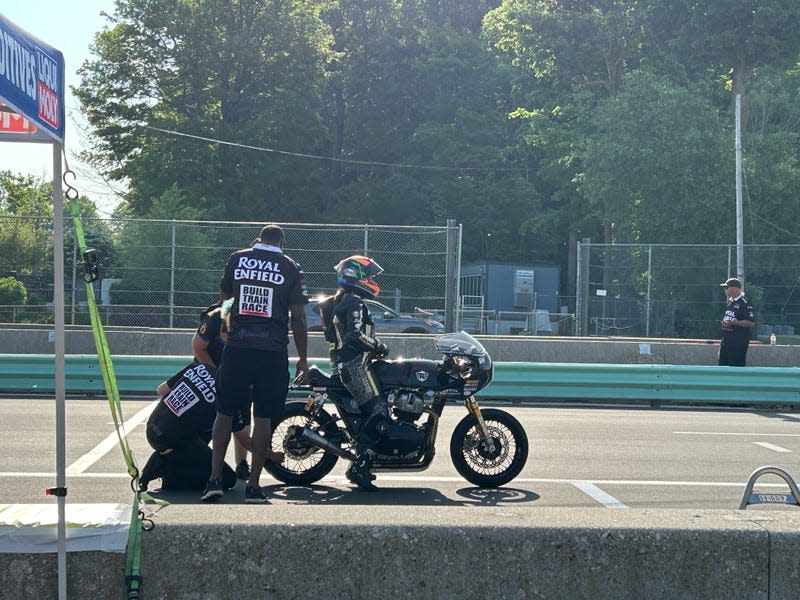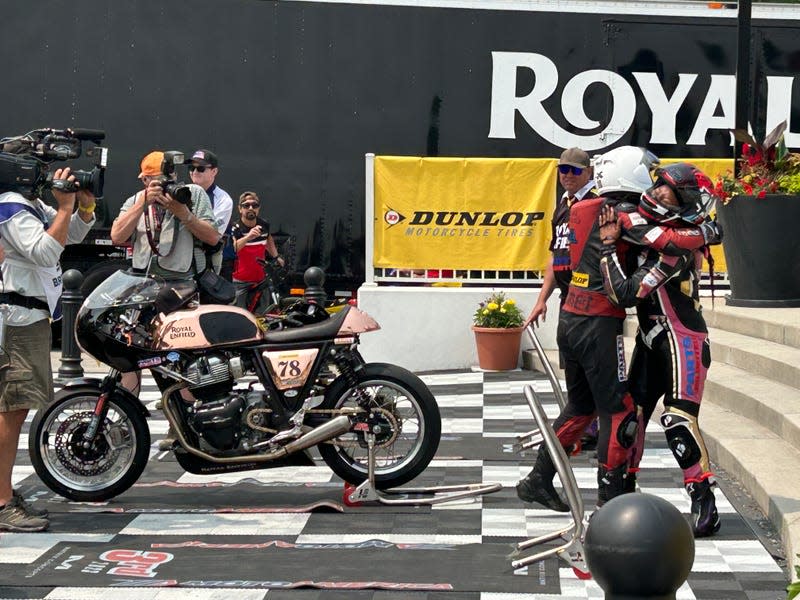From Rookie To Pro Rider: How Royal Enfield Is Creating A New Generation Of Female Motorcycle Racers
Seconds after parking on a hill in the infield at Road America, I’m summoned trackside by the crescendo of a field of deep, guttural engines. At first it sounds like multiple vintage bikes racing around the corner, but this is a MotoAmerica race weekend, and there’s nothing remotely vintage on the schedule. I wait for the source to peek out from the tree line and pass my sliver of track, hoping to catch a glimpse of what it was I was hearing before it disappeared into yet another tree line.
They look vintage, but they’re not vintage. The retro-looking bubble farings are designed for show and function, as well as to compliment the classic-inspired bikes being put through their paces on the track. If you had no idea at first glance what these bikes are, you’d think it was a classic bike run. But, what you’re really seeing is a pro MotoAmerica class of Royal Enfield Continentals racing, piloted by an entire group of female riders. This is Royal Enfield’s Build. Train. Race. program.
Read more
Full disclosure: This was part of an epic racing weekend set up by our friends at MotoAmerica and Royal Enfield. Mostly, they provided me a hotel for the weekend, but I drove and fed myself, while enjoying the company of true motorcycle enthusiasts along with some wicked fast motorcycle racing.
Royal Enfield’s Build. Train. Race.
Now you’re thinking, Royal Enfield? Racing? That’s just one of the many fun things about the program. It’s putting an unexpected Indian (formerly British) bike among a part of the motorcycle world (in regards to road racing) that has been dominated by Japanese and Italian manufacturers. Luckily, these Enfields are not up against any of those long-storied bike makers — they race in a class of their own.
The other unique and unexpected aspect to the program is that every rider racing in the Build. Train. Race. (BTR) program is a selected female rider who has had no or limited experience racing. Rider Kayleigh Buyck started with the BTR class of 2022 with some competition under her belt. But another rider, returning for the 2023 season, Hannah Stockton, had only been riding for maybe a year, with one track day to her name. Mikayla Moore is also new this 2023 season, but she’s not new to riding or racing at all — having been riding since she was six, racing since 12, and maybe the proof is in the pudding in that way — the now 19-year-old has swept every race weekend this season.
Each of these women applied to be a part of Royal Enfield’s BTR program, and were the lucky handful selected from the hundreds of applicants to be a part of the pro-level series. Sure, most of the 12 women in the paddock are fairly new to the racing game, but this series is serious. They were hand selected to be pros, racing among a weekend of other serious pro-riders as part of the MotoAmerica series.
MotoAmerica Royal Enfield Build. Train. Race. Race 1 Highlights at Road America 2023
What they signed up for would be a challenging and incredible several months of building their own race bikes, learning how to race from World Champion motorcyclist Freddie Spencer, taking all of their skills to the track in the hopes of improving as a rider and a racer, and maybe winning a real championship themselves. All while holding down their full-time jobs.
The Build.
Riders participating in the RE’s Flat Track or Road Racing BTR program are provided a Royal Enfield bike to build into a racing machine. Flat Track participants receive an INT650 to ready for dirt tracks, while participants with the road racing program receive a new Continental 650. Prior to the 2023 season, riders would receive their new race bike at home, where for three months they would learn to tear it apart and build it up to race-sanctioned standards before it was picked up to be delivered to the first race.
Buyck, a 2022 BTR rider returning for the 2023 season, was significantly surprised at the arrival of that very new bike for the previous season. Then it was all-in turning the classic-inspired roadster into a bonafide race bike.
“You break it down to frame and motor — the only things we weren’t able to touch,” Buyck shared. “Other than that, I tore everything apart. I’m cutting pieces off or reducing the weight. And then I’m looking at it — realizing I have to put this back together.”
A second-year rider, Stockton, faced a bit more of a challenge when her bike finally arrived. The bike was originally at home in the garage, but she quickly found she didn’t have all the tools to build the bike, nor the knowledge to know where to start.
“I was constantly having to load the bike and take it somewhere else to use a tool or whatever. I wound up finding a community garage in Kansas City called Hickory Union Moto. You pay a membership, and you leave your bike there; they have all the tools, and they have people that work there that will guide you through it. And they can teach you anything you want to know.”
Stockton added, “We had more of a build kit that we had to do. But from there, it was kind of up to you to figure it out. And I struggled with figuring it out, because I didn’t know anything. When they said you’re going to change gearing, I thought we were changing gearing in the motor. How are we going to change gearing at the track? That doesn’t make sense to me. I didn’t know you could change a sprocket. I didn’t know what a quick shifter was — there [were] lots of things that I didn’t know.
“I thought we were changing gearing in the motor. How are we going to change gearing at the track? That doesn’t make sense to me. I didn’t know you could change a sprocket. I didn’t know what a quick shifter was — there [were] lots of things that I didn’t know.”
The six new-to-BTR riders for the 2023 season were given a little bit of a different experiment for this year’s bike building. Instead of getting bikes at home, they were brought down to Texas to build their bikes together with support from Royal Enfield. There, for three days, riders were provided the proper tools and had experts on hand to help with any particular struggles on the build. They were making modifications to lighten up the bike but also put on sponsored manufacturer parts that were more appropriate for racing. A stock Continental 650 isn’t something to bat your eyelashes at, but a few adjustments make it a suitable track beast for a team of new riders.
The end result is not only a race bike, but a field of self-sufficient women who can build an entire bike and know every part that’s on it. They’ll learn how those parts affect their riding, and they become their own pit crew, able to make quick adjustments on the fly to suit their riding needs.

 Yahoo Autos
Yahoo Autos 


